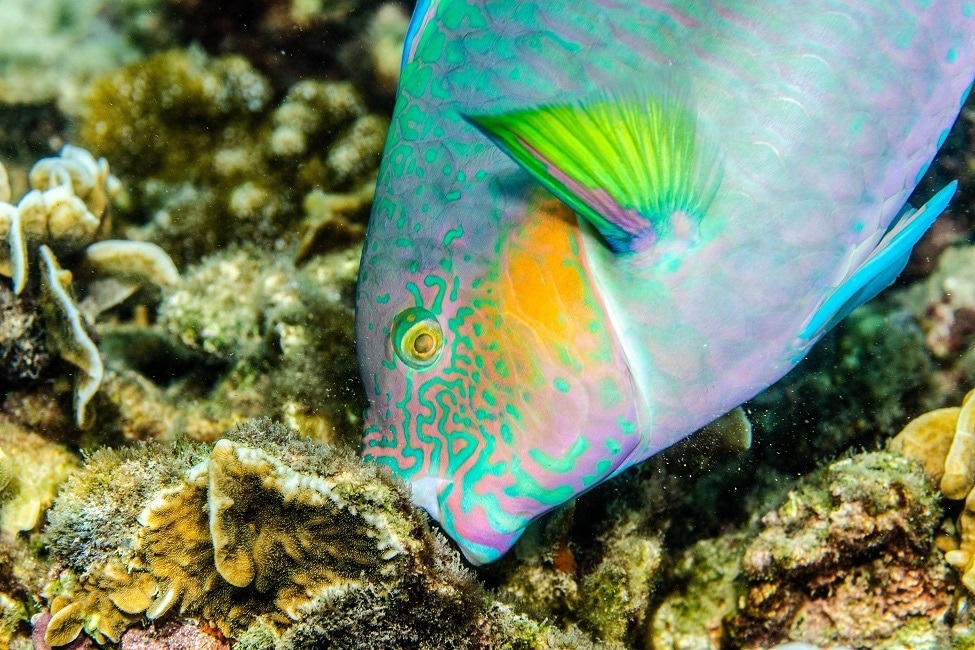Over half a billion people rely on fisheries, ecotourism, storm surge protection, and other resources from tropical coral reefs.

Researchers will work to understand interactions among diverse fish species and how coral reef fish herbivory rates emerge at the ecosystem scale and respond to environmental change. Image Credit: Michael Gil, Ph.D.
Even though these communities have deep concerns regarding the fate of coral reefs, they frequently lack the scientific tools to record changes in the local reefs on which they depend.
Scientists from the Florida Atlantic University, the University of Colorado at Boulder, the University of New Mexico, and the University of California, Santa Cruz, have obtained a five-year, $3 million grant from the National Science Foundation for a project to authorize community members already sectioned in coral reef health to use required to document variations in such systems. Significantly, outcomes from the study will notify the management of ecosystems.
Among the prevalent theories for the worldwide downfall of coral reef ecosystems is that due to a loss of herbivorous fishes via ecological change, algae outcompete corals, resulting in the failure of earlier successful coral ecosystems.
Thus, the ecological function of herbivory or so-called “primary consumption” by this fish community is of crucial ecological significance since it can identify the state of the ecosystem.
Building on their earlier work in coral reef systems, the interdisciplinary study group will work to comprehend how herbivory rate at the ecosystem scale arises, reacts to environmental change, and forms the ecosystem leading to different networks of coral reef fish that are concurrently mutualists and competitors.
In coral reefs, the behavior of diverse assemblages of herbivorous fish is readily observable. These fish feed on benthic or seafloor-attached algae, which compete for limited space with coral species that lay the physical foundation of the ecosystem.
Ashkaan K. Fahimipour, PhD, Study Co-Principal Investigator and Assistant Professor, Department of Biological Sciences, Charles E. Schmidt College of Science, Florida Atlantic University
Fahimipour added, “Yet, how collective herbivory emerges in these ecosystems is poorly understood and ultimately hinges on ‘multivalent’ interactions among diverse fish species.”
Fahimipour; Michael Gil, Ph.D., principal investigator and an assistant professor at the University of Colorado at Boulder; Melanie Moses, Ph.D., co-PI, a professor in the Department of Computer Science at the University of New Mexico and an external professor at the Santa Fe Institute; and Andrew M. Hein, Ph.D., co-PI and research group leader at NOAA and the University of California, Santa Cruz’s Institute of Marine Sciences, will quantify how multivalent interactions among the fish species tend to impact their consumption behavior.
The so-called “Multivalent” interactions, in which biological units concurrently impact one another in qualitatively diverse ways, are discovered in systems at virtually all levels of the organization.
Instances include bacteria that contend for nutrients, genes that consult antibiotic resistance and tree species that share carbon and info chemicals as they contend for light and water. Also, multi-species groups of birds, fish, and mammals compete for food and exchange data regarding shared predators.
“As we begin to recognize the prevalence and dynamical significance of multivalent interactions, it is clear that we must develop new frameworks for studying how this feature of complex biological systems impacts emergent system function and responses to environmental change,” stated Gil.
For the project entitled, “URoL:EN: Emergence of Function and Dynamics from Ecological Interaction Networks,” the team will empirically determine and mathematically describe the modes of interactions among various reef fish species to identify the structure and develop multivalent interactions present in the system.
Furthermore, they will develop new analytical and computational techniques to comprehend the Rule of Life that regulates how system-scale function and dynamics. This includes reactions to environmental change that emerges from such interactions.
Although we will apply these methods to coral reef ecosystems, the theoretical framework we develop for understanding the structure, evolution, and dynamics of multivalent interaction networks will be general and, therefore, directly applicable to myriad complex biological systems that are subject to this Rule of Life.
Ashkaan K. Fahimipour, Ph.D., Study Co-Principal Investigator and Assistant Professor, Department of Biological Sciences, Charles E. Schmidt College of Science, Florida Atlantic University
Through collaborations with local organizations like the Caribbean Research and Management of Biodiversity in Curaçao, Coral Gardeners in Mo’orea, French Polynesia, and the Ecoinformatics Laboratory in Thailand, scientists will connect with local stakeholders like grassroots conservation groups, local fishing cooperatives, and tour operators at each of the study locations.
The pilot citizen science program will authorize local communities to add up to global environmental tracking. Scientists will work with stakeholders to determine the metrics of reef health that are highly applicable to them and will offer them small, man-portable camera observatories powered by the same technologies utilized in their large-scale observatories.
Because of their low cost and scalability and the data standardization they provide, the camera and automated processing/analysis technologies developed in our technical project plan have the potential to democratize access to scientific tools, empowering local, on-the-ground coral reef monitoring efforts.
Michael Gil, Ph.D., Study Principal Investigator and Assistant Professor, the University of Colorado at Boulder
Also, scientists will set up a paid cross-institutional research assistantship for undergraduates from underrepresented groups concentrated on developing cross-disciplinary quantitative skills.
Besides, the researchers will work towards creating a social media video series presenting the experiences of different undergraduate and early-career scientists supported by this grant to humanize and demystify the process of scientific discovery and its significance to individuals and society.